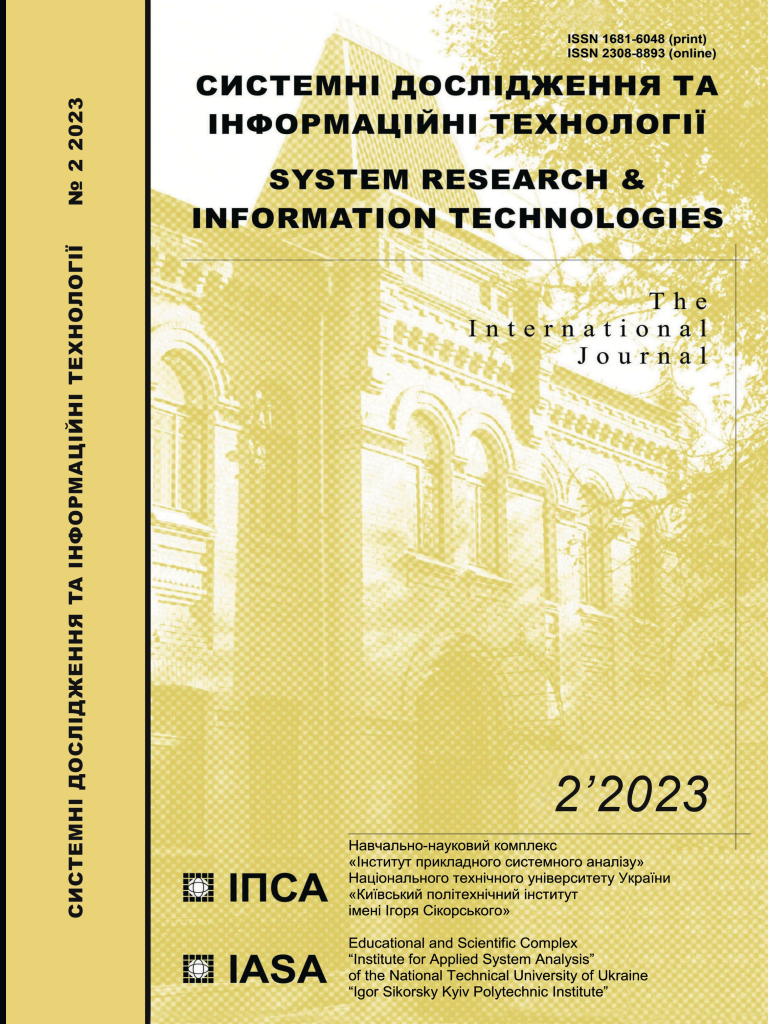The algorithm for predicting the cryptocurrency rate taking into account the influence of posts of a group of famous people in social networks
DOI:
https://doi.org/10.20535/SRIT.2308-8893.2023.2.02Keywords:
cryptocurrency exchange rate, forecasting algorithms, social media posts, group of experts, “main” expert, information technology of intelligent analysisAbstract
This article presents an algorithm for predicting the rate of a selected cryptocurrency, taking into account the posts of a group of famous people in a particular social network. The celebrities chosen as experts, i.e., famous personalities whose posts on social networks were studied, are either familiar with the financial industry, particularly the cryptocurrency market, or some cryptocurrency. The dataset used was the actual rates of the cryptocurrency in question for the selected period and the statistics of expert posts in the selected social network. The study used methods such as the full probability formula and the Bayesian formula. It was found that posts by famous people on social media differently affected cryptocurrency rates. The “main” expert was identified, and his posts were used to forecast the selected cryptocurrency’s rate.
References
P. Preethi, V. Uma, and A. Kumar, “Temporal Sentiment Analysis and Causal Rules Extraction from Tweets for Event Prediction,” Procedia Computer Science, no. 48, pp. 84–89, 2015. Available: https://doi.org/10.1016/j.procs.2015.04.154
Matthew S. Gerber, “Predicting crime using Twitter and kernel density estimation,” Decision Support Systems, no. 61, pp. 115–125, 2014. Available: https://doi.org/10.1016/j.dss.2014.02.003
O.V. Gavrilenko and I.V. Kuptsova, “Research of tasks of estimation of objects in computer social networks by means of reliable algorithms [Text],” materials of the 8th international scientific and technical conference “Modern directions of development of information and communication technologies and means of management”, Kharkiv, April 26–27, 2018, pp. 67–68.
A. Culotta and B. Huberman, “Towards detecting influenza epidemics by analyzing Twitter messages,” Proceedings of the First Workshop on Social Media Analytics, ACM, 2010, pp. 115–122.
M. Chau and J. Xu, “Mining communities and their relationships in blogs: A study of online hate groups,” J. Hum.-Comput. Stud., 65(1), pp. 57–70, 2007.
O.V. Gavrilenko, “Review of methods of hybridization of intellectual information processing,” Scientific Bulletin of Kherson State University, series “ECONOMIC SCIENCES”, issue 8, part 3, p. 1, pp. 204–207, 2014.
O.V. Gavrylenko, K.D. Novakivska, and O.A. Shumeiko, “Selection of the most influential economic factors for forecasting the US dollar exchange rate,” NTU Bulletin, no. 54, pp. 26–35, 2022. doi: 10.33744/2308-6645-2022-4-54-026-035.
O. Gavrylenko, M. Miahkyi, and Y. Zhurakovskyi, “The task of analyzing publications to build a forecast for changes in cryptocurrency rates,” Adaptive Automatic Control Systems, vol. 2, no. 41, pp. 90–99, 2022. Available: https://doi.org/10.20535/1560-8956.41.2022.271349
Binance cryptocurrency exchange. [Online]. Available: https://www.binance.com/en/strategy/spot/grid/DOGEUSDT.Accessedon:20April2023.
M.V. Kartashov, Probability, processes, statistics. Kyiv: VPC Kyiv University, 2007, 504 p.
V.P. Denysiuk, V.M. Bobkov, T.A. Pogrebetska, and V.K. Repeta, Higher mathematics. P4. Probability theory and mathematical statistics. Kyiv: NAU-druk, 2009, 256 p.
Time series. [Online]. Available: https://kstat.pnu.edu.ua/wpcontent/uploads/sites/63/2018/04/%D0%A7%D0%B0%D1%81%D0%BE%D0%B2%D1%96-%D1%80%D1%8F%D0%B4%D0%B8.pdf.Accessedon20April2023.

